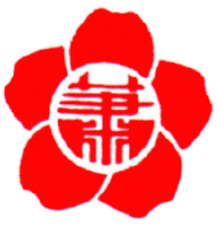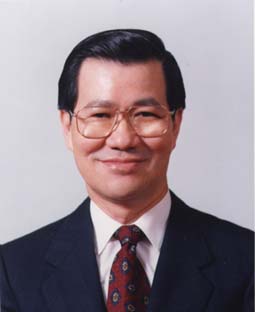
 Vincent C. Siew was born on January 3, 1939, in Chiayi
City, Taiwan Province, the Republic of China (ROC). He graduated from Chiayi
High School in 1957 and from the Department of Diplomacy at National Chengchi
University in 1961. After completing his compulsory military service, Mr.
Siew passed the Foreign Affairs Special Examination of 1962 with top marks.
He subsequently earned a master's degree from the Graduate Institute of
International Law and Diplomacy at National Chengchi University in 1965,
completed a leadership seminar at Georgetown University of the USA in 1982,
and was awarded the Eisenhower Fellowship in 1985.
Vincent C. Siew was born on January 3, 1939, in Chiayi
City, Taiwan Province, the Republic of China (ROC). He graduated from Chiayi
High School in 1957 and from the Department of Diplomacy at National Chengchi
University in 1961. After completing his compulsory military service, Mr.
Siew passed the Foreign Affairs Special Examination of 1962 with top marks.
He subsequently earned a master's degree from the Graduate Institute of
International Law and Diplomacy at National Chengchi University in 1965,
completed a leadership seminar at Georgetown University of the USA in 1982,
and was awarded the Eisenhower Fellowship in 1985.
Mr. Siew began his civil service career at the Ministry of Foreign Affairs in 1962. In April 1966, he was appointed vice consul at the ROC's Consulate General in the Malaysian capital of Kuala Lumpur, and in 1969 he was promoted to consul, a position he held until 1972. During his tenure there, he built up a very close relationship with the governments and peoples of Malaysia and Singapore. He also successfully negotiated the establishment of the ROC Trade Representative Office in Singapore and its counterpart in Taipei. In addition, his services to overseas Chinese in the region were highly regarded.
After the withdrawal of the Republic of China from the United Nations in 1971 and amid massive changes within the international community, Mr. Siew was determined to return to Taiwan. Once home, he became a section chief in the East Asian & Pacific Affairs Department at the Ministry of Foreign Affairs. He thought that the future of the ROC's foreign relations depended on developing substantive economic and trade relationships to consolidate bilateral ties and heighten national prestige. He therefore joined the Board of Foreign Trade (BOFT) under the Ministry of Economic Affairs later in 1972, where he rose first from inspector to department director and finally to deputy director-general. Trade negotiations and market promotion were two areas to which he was particularly dedicated. Prior to the severance of diplomatic ties between the ROC and the US in 1979, he shuttled between Washington and Taipei and negotiated a bilateral most-favored-nation trade agreement. The consummation of this mission laid the groundwork for economic and trade cooperation between the ROC and the US despite the severance of diplomatic relations.
In January 1982, Mr. Siew became director-general of the Board of Foreign Trade. During his six-year tenure, he worked toward simplifying laws and regulations and strengthening personnel management at the BOFT. Taiwan was ripe at that time for the development of a trade-oriented economic structure. However, mounting trade surpluses had caused increasing tension with trade partners. Mr. Siew thus took the lead and pursued trade talks to resolve the problem. His remarkable leadership skills won him national popularity at home and admiration from his counterparts abroad. To reduce Taiwan's trade surplus with the United States, he led trade missions to a total of 46 US states as part of a campaign that drew considerable attention. Moreover, he participated in a number of additional trade missions, often acting as chief, to major trading nations to enhance economic and trade relations and resolve trade disputes. All this contributed invaluably to the speedy growth of Taiwan's economy and trade.
During his tenure as the Board of Foreign Trade's director-general, Mr. Siew vigorously promoted trade liberalization and globalization. In addition to drafting trade laws and simplifying administrative procedures, he authorized banks to process import-export permits, promoted professional training, and introduced a rotating system for economic and trade representatives stationed overseas. His unfailing efforts helped build the ROC's very substantial foreign exchange reserves and make the ROC the world's 13th largest trading nation.
As a member of the ruling Kuomintang (KMT), Mr. Siew was elected in July 1988 to the KMT Central Committee. At about the same time, he was appointed vice chairman of the Council for Economic Planning and Development (CEPD) under the Executive Yuan. While at the CEPD (1988-1989), he promoted major infrastructure projects such as the straightening of the Keelung River, the placement of Taipei City rail lines underground, the construction of the East-West Highways, the diversion of the Chichi River, and the expansion of the Kaohsiung International Airport.
In December 1989, Mr. Siew was selected to serve as director-general of the Department of Organizational Affairs under the Central Committee of the ruling KMT, where he was responsible principally for managing President Lee Teng-hui's re-election campaign and other campaigns at the local level.
With the appointment of a new premier in June 1990, the cabinet was reshuffled and Mr. Siew was appointed Minister of Economic Affairs. His appointment came at a time fraught with confrontation over the environment and problems arising from stagnant investment and slow economic growth. In a short period of six months, he successfully settled a five-year dispute with environmentalists that had been blocking Chinese Petroleum Corporation's construction of a fifth naphtha cracker plant. He also settled a ten-year dispute between a local government and a community over the construction of the Changpin Industrial District. Moreover, he succeeded in persuading Formosa Plastics Corporation to invest in a major construction project, the sixth naphtha cracker plant, in Yunlin. Mr. Siew also overcame a legislative freeze of the budget for Taiwan's fourth nuclear power plant.
During his tenure of two years and eight months as Minister of Economic Affairs, Mr. Siew promoted major investment programs, removed investment barriers, enhanced investment incentives, and initiated the privatization of such state enterprises as China Steel, BES Engineering, and China Petrochemical Development. He also eased government controls on cross-strait trade and investment. As the head of delegations to Europe as well as Central and South America, he explored opportunities for international economic and trade cooperation and thereby contributed to the promotion of trade diplomacy.
In November 1991, Mr. Siew represented the ROC at the Asia-Pacific Economic Cooperation (APEC) ministerial conference held in Seoul, at which Taipei, Peking and Hong Kong were granted membership. In November 1992, he again represented the ROC at the APEC ministerial conference held in Bangkok, and, after a series of bumpy negotiations, secured formal observer status for the ROC in the General Agreement on Tariffs and Trade (now the World Trade Organization).
In March 1993, Mr. Siew was appointed chairman of the Council for Economic Planning and Development under the Executive Yuan. His economic stimulus package announced in June of that year was aimed at promoting steady economic growth, as Taiwan's economy was at that time experiencing stagnant export growth and production levels. In August 1993, he completed a review of the ROC's Six-Year National Development Plan and assigned priorities to projects on the basis of the availability of resources and the maintenance of financial stability. In July 1994, he undertook major administrative reform with the introduction of a program to streamline bidding procedures for public construction projects and government procurement. Finally, in a bid to usher Taiwan into the 21st century, Mr. Siew initiated a program to develop Taiwan into an operations center for the Asia-Pacific region.
Mr. Siew represented President Lee Teng-hui in November 1993 and again in November 1994 at the APEC summit meetings held respectively in Seattle and Jakarta. At the two meetings, he presented papers on the ROC's successful experience in the development of agriculture and small- and medium-sized enterprises. The action plans proposed in the papers won APEC's support and helped promote Taiwan in the international trade and investment arenas.
In December 1994, Mr. Siew was appointed chairman of the Mainland Affairs Council under the Executive Yuan. To encourage the development of cross-strait relations through trade and investment activities, he proposed a fresh series of measures and actions to relax restrictions on trade with and investment in the Chinese mainland.
In 1995, the ruling KMT recruited him to run for a seat in the Legislative Yuan (the national legislature) as a candidate from his native city of Chiayi, where the KMT had been unsuccessful for many years in elections at both the local and national levels. He immediately returned to Chiayi to face the opposition party challenge and participate in his first popular election. Following a hard-fought campaign, he won the election on a platform calling for the overall development of Chiayi and the integration of the city into the national development program.
In the spring of 1996, Mr. Siew acted as the chief campaign manager for Lee Teng-hui and Lien Chan in the first direct popular election of a president and a vice president in the history of the ROC. He set up a campaign headquarters and campaign offices in strategic areas around Taiwan to mobilize strong support. His efforts were an invaluable contribution to the campaign, and in the end, the Lee-Lien ticket won with 54 percent of the vote, surpassing the other three electoral tickets by a wide margin.
After the presidential election, Mr. Siew returned to his duties as a legislator, maintaining his humility and his affection for the country and its people. He frequently visited his voter service office in Chiayi, where he addressed the demands of his constituents. In view of the need for greater national competitiveness and economic revitalization, he worked hard to promote consensus-building among legislators of the ruling and opposition parties, and to hasten the enactment of urgently needed financial and economic legislation. As a result of his efforts, a caucus to expedite financial and economic legislation was organized on September 6, 1996, with 77 legislators from various parties as members. Mr. Siew was selected to head the caucus with the overwhelming support of members.
First in August 1992 and again in August 1996, Mr. Siew was elected to the Kuomintang's Central Standing Committee. These two consecutive terms clearly affirm the respect for his numerous achievements at different stages of his career as a government leader, an outstanding member of the ruling party, and a prominent national legislator.
Mr. Siew is a modest and pleasant man with a strong affinity for the
public. His constant smile has earned him the nickname "Smiling Siew."
He also enjoys a happy family life. His wife Susan Chu, a graduate of National
Chengchi University's Department of International Trade, is her husband's
most solid supporter. The couple have three daughters. Two have earned
their master's degrees and are married, while the youngest is still in
school.
| °h ¦^ BACK |
|---|